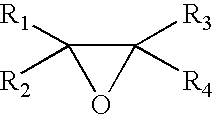Transparent thermoplastic blend of a cycloolefin copolymer and a thermoplastic polyurethane
- Summary
- Abstract
- Description
- Claims
- Application Information
AI Technical Summary
Benefits of technology
Problems solved by technology
Method used
Image
Examples
examples
The ingredients set forth in Tables 1 and 2 (Examples A through P) were blended in a Werner Pfleiderer® model ZSK 30 twin screw extruder under the following general conditions: Rate: 25-35 lbs / hour Rpm: 175 Temperatures (C): Zone 1: 165 Zone 2: 175 Zone 3: 185 Zone 4: 190 Zone 5: 190 Zone 6: 185 Die: 170 Amps: 40
Specimens used for physical, electrical, and cleanliness testing were injection molded.
Luminous transmittance % was tested on a Perkin Elmer Model Lambda® 9 Spectrophotometer. 0.125″ thick samples were scanned from 400-860 m at a rate of 240 nm / min. The light source was a Tungsen-halogen lamp. Slit width was 2 nm and the reference sample was air. Percent transmittance is reported at 700 nm.
Optical properties are determined according to ASTM D-1003 and include light transmission and haze values.
Clear compositions were made according to the following recipes shown in Examples A through J wherein the parts listed are by weight. Additional examples are given ...
PUM
| Property | Measurement | Unit |
|---|---|---|
| Fraction | aaaaa | aaaaa |
| Fraction | aaaaa | aaaaa |
| Fraction | aaaaa | aaaaa |
Abstract
Description
Claims
Application Information
 Login to View More
Login to View More - R&D
- Intellectual Property
- Life Sciences
- Materials
- Tech Scout
- Unparalleled Data Quality
- Higher Quality Content
- 60% Fewer Hallucinations
Browse by: Latest US Patents, China's latest patents, Technical Efficacy Thesaurus, Application Domain, Technology Topic, Popular Technical Reports.
© 2025 PatSnap. All rights reserved.Legal|Privacy policy|Modern Slavery Act Transparency Statement|Sitemap|About US| Contact US: help@patsnap.com



